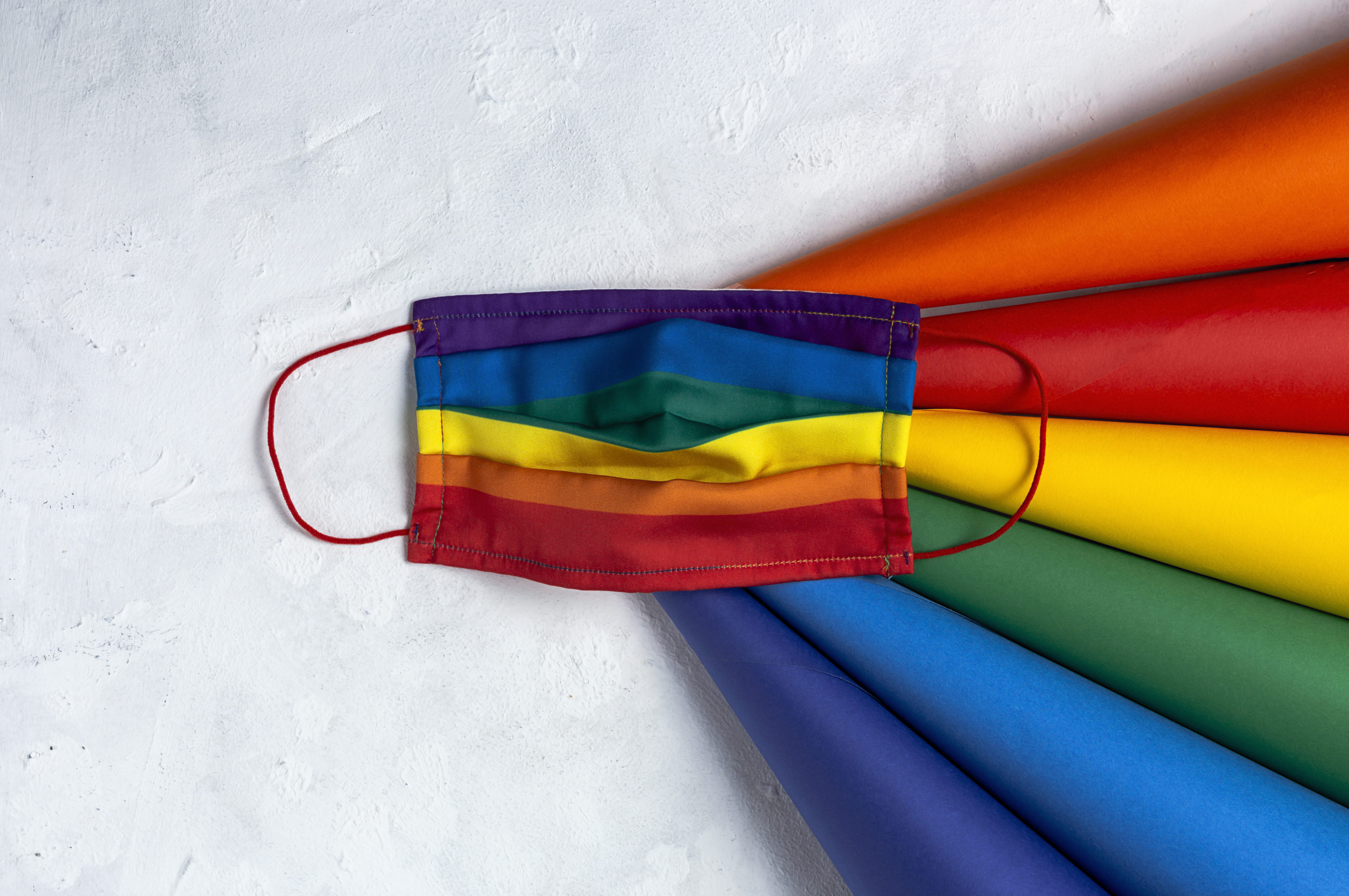Although higher proportions of people have been vaccinated and more countries are lifting restrictions for COVID-19 globally, the mental health impacts of the COVID-19 pandemic and lockdowns are still being studied.
A recent article, published in the Journal of Homosexuality, explores the psychosocial effects of the COVID-19 pandemic and mental health among LGBTQ+ young adults. The cross-cultural study focuses specifically on LGBTQ+ young adults who are confined with their parents during the pandemic. This group may be particularly vulnerable to impacts on their emotional well-being and mental health during the pandemic.
“Our exploratory research aims to investigate the effects of the COVID-19 pandemic on mental health symptoms among LGBTQ+ young adults confined with their parents (or similar family configuration) in Portugal, UK, Italy, Brazil, Chile, and Sweden,” the lead author, psychologist Jorge Gato from the University of Porto, notes.
“Family of origin often reflects the wider societal stigma and becomes a source of discrimination for LGBTQ+ individuals, increasing mental distress during adolescence and into young adulthood.”

Over the past year, studies have found that the pandemic and quarantine have been associated with increased fear of infection, social isolation/loneliness, financial loss, and stigma. Not surprisingly, previous research based on minority theory has found higher levels of depression and anxiety among LGBTQ individuals than heterosexual peers. In addition, studies showed LGBTQ+ individuals, who reside with their parents, reported greater stress levels due to the effort to conceal their sexual and/or gender identity during the pandemic.
“Both distal (e.g., violence, discrimination) and proximal stressors (e.g., the expectation of rejection, concealment) can be amplified for some LGBTQ+ individuals in situations of isolation, such as government restrictions to avoid the spread of COVID-19,” the authors explain. “The stay-at-home orders, closure of higher education institutions, and/or teleworking measures may have confined LGBTQ+ young adults to potentially negative home environments.”
The study was a joint effort of 16 academics from South America (Brazil, Chile) and Europe (Portugal, UK, Italy, and Sweden). The study recruited 1,934 participants between 18 and 29 years old who either resided habitually with their parents or had returned to their parents’ home during the pandemic.
“The study is also informed by family system theory which suggests that individual development and adaptation is shaped not only by the family subsystems (e.g., parents and children) but also by the broader socio-cultural context,” the authors add.
To explore the differences in the psychosocial effects of the pandemic by country of origin, the study takes the broader social context into account, including the social acceptance of sexual and gender minorities from each country, the differences in the local severity of the pandemic, and the difference in the local measures implemented to prevent COVID-19 spread.
“Because of dissimilarities in the acceptance of LGBTQ+ individuals, as well as differences in the local severity and management of the present health crisis, we expected the psychosocial effects of the pandemic to be more pronounced in South American countries than in European countries,” the authors write.
“Second, we explored the psychosocial effects of the COVID-19 pandemic on reported mental health symptoms among participants, controlling for sociodemographic characteristics. Given the exploratory nature of this research, hypotheses were not formulated.”
The study collected sociodemographic data including participants’ age, sex assigned at birth, gender identity, sexual orientation, relationship status, educational level, work status, their level of confinement at home due to government restriction (totally, partially, or not confined), and whether they resided habitually or had returned to their family home.
Participants were asked to answer the depression and anxiety subscales (a 4-point Likert scale) of the Depression, Anxiety, and Stress Scales (DASS-21) with anxiety subscale measuring physical arousal symptoms, panic attacks, and fear and depression subscale measuring symptoms associated with negative mood.
To assess the psychosocial effects on the COVID-19 pandemic, the participants answered the following seven items (rated on Likert scale from 0 to 10):
- To what extent has the COVID-19 pandemic affected your life?
- To what extent has the COVID-19 pandemic affected you emotionally?
- How afraid are you of becoming infected with COVID-19 in the future?
- To what extent do you feel uncomfortable in your household in the current situation?
- To what extent do you feel ‘suffocated’ because you cannot express your LGBTQ+ identity with your family/ the people you live with in the current situation of confinement?
- To what extend has the COVID-19 pandemic made you feel isolated from your non-LGBTQ+ friends?
- To what extent has the COVID-19 pandemic made you feel isolated from your LGBTQ+ friends?
The researchers found differences between countries regarding the effects of the pandemic. The results provide insight into the predictors of mental health outcomes. Participants in South America reported that they felt more “suffocated” because they could not express their LGBTQ+ identity with their family in the situation of confinement, which may be partly explained by the difference regarding the acceptance of LGBTQ+ individuals across the two continents.
“Participants in Brazil and Chile reported significantly more negative psychosocial effects of the pandemic. Conversely, the four European countries did not differ on most of the variables and displayed lower levels of concern about psychosocial effects of the pandemic when compared to their South American counterparts,” the authors explain. “While among sociodemographic variables only age, educational level, and work status correlated with depression and anxiety, all the psychosocial effects of the pandemic significantly correlated with the outcome variables.”
They find that sociodemographic predictors were weaker predictors of mental health outcomes than psychosocial effects of the pandemic. The emotional effect of the pandemic was a moderate predictor of both depression and anxiety.
Higher levels of depressive symptoms were found among participants who were (1) younger, (2) less educated, (3) not working, (4) living in a European country, (5) felt more emotionally affected by the pandemic, (6) felt more uncomfortable at home, (7) felt more isolated from their non-LGBTQ friends.
Higher anxiety levels were found among participants who were (1) younger, (2) not working, (3) living in a European country, (4) felt more emotionally affected by the pandemic, (5) felt more uncomfortable at home, (6) felt more isolated from their non-LGBTQ friends, (7) resided habitually with their parents, (8) not totally confined at home, and (9) more afraid of being infected.
Local severity of the COVID-19 pandemic and governmental measures may have also played an important role in the above-mentioned differences. The results show that fear of infection was significantly greater in South America than in Europe. This result might be accounted for by a realistic appraisal of the psychosocial effect of the pandemic in Brazil and Chile, where the infection rates and death were on the rise at the time of data collection.
“Younger individuals with a lower educational level, and without a job have less access to financial resources and are likely to be more dependent upon their family of origin than their employed peers, which may have contributed to increased vulnerability in terms of their mental health during the COVID-19 pandemic,” the author’s write.
“The association of an un-affirming or hostile family climate with higher levels of depression and anxiety may be particularly concerning given the impact of stigma on LGBTQ young adults’ mental health.”
The authors conclude:
“Findings suggest that LGBTQ+ community groups, health and educational services, and other social support networks need to remain particularly attentive and available during a period of confinement to meet the need of LGBTQ+ young adults.”
****
Gato, J., Barrientos, J., Tasker, F., Miscioscia, M., Cerqueira-Santos, E., Malmquist, A., … & Wurm, M. (2021). Psychosocial effects of the COVID-19 pandemic and mental health among LGBTQ+ young adults: a cross-cultural comparison across six nations. Journal of Homosexuality, 68(4), 612-630. (Link)















This study has several obvious flaws. The first of which is that almost all of the questions are leading in nature, suggesting feelings that a person may not have identified in themselves before hearing that they might feel that way. Second, since when has “uncomfortable” been a feeling to avoid rather than to learn how to feel and be ok with?
What I would want to know from youth is whether they are safe in their homes. This trend, which has been ongoing for a couple of decades, has been feeding the narrative that differentiation from parents beliefs makes their parents bad and is terribly damaging to their mental health. It fuels discontent between parents and children and increases mental distress. Adolescence is a time of tumult for good reason. Normal development means learning what you believe and how it differs from your family.
There is a very big difference between the parent who throws their child out on the street or beats them or otherwise does actual harm and the parent who disagrees with their child’s lifestyle or beliefs and states as much.
What I’ve noticed is that parents who fall all over themselves to celebrate whatever their child believes or identifies as is seen as a good parent and the ones that don’t are somehow bad or emotionally harming their child. Most parents who disagree with their children’s identities aren’t actually telling their kids they’re going to hell or calling them fags or trannies. They’re simply concerned and expressing healthy differences of belief. But kids go online and hear a different story. They hear that if their parents aren’t effusively and openly supportive, there will be dire consequences for their mental health and that they might even kill themselves.
Can no one actually see the difference here between a situation of abuse and a situation where discomfort is a part of growing up and maturing and being ok in your own skin?
My grandmother never accepted my mother’s homosexuality as something that was right with God but she was also the epitome of love. She believed in loving the sinner and hating the sin. She never lectured or brought it up. She just didn’t approve and that was that. She and my mother had a loving healthy relationship and she was the stablest adult in my life growing up. If there is anyone I want to be like, it was her. I will never merely approve of something a child or teen does that goes against my values just so they can avoid feeling discomfort.
So this idea that younger generations are getting, that love and a healthy relationship means total approval of whatever you believe or identify as seems to be more problematic. Disagreement with your parents and families is normal and healthy and necessary.
But this kind of encouragement for teens to openly defy their families norms is happening across the board on many issues, not just lgbt. It happened to me as a teen and created much deeper rifts between my family and I than were already there. It increased despair, encouraged me to feel more hostile and belligerent, arrested my own emotional growth and ability to learn how to get along, and was the direct catalyst for my first hospitalization as a teen. And these messages were coming from adults, not other teens. My struggles with my family actually ended some of my friendships with people my own age because my own emotional turmoil was alienating. And we need to understand that these cultural messages are still coming from adults, even if teens are more connected now and spreading it amongst themselves.
If we cared about teens long term psychological development, the questions we’d be asking them are: are you fed, are you clothed, are you experiencing actual physical or psychological abuse? But instead, what we’re teaching them through these narratives is that discomfort is to be avoided and if their families cause them to experience discomfort, they should reject them as non loving and nonsupportive. I hope we don’t wonder why then they end up in therapy and on psych drugs after rejecting their families and going through entirely predictable trajectories that didn’t need to occur.
Report comment